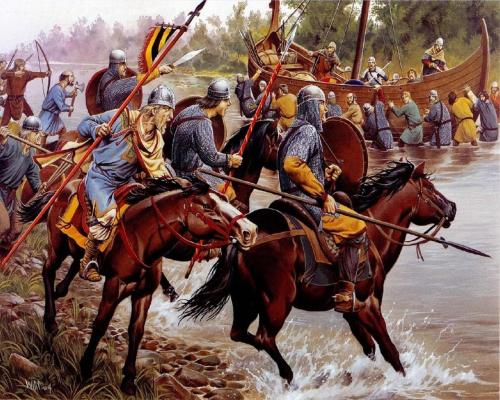Carolingians seize power from Merovingians. By the late seventh century, the Frankish Merovingians were in decline. Real power had passed to three mayors of the palace (in Neustria, Austrasia, and Burgundy), who had been able to acquire large territories for themselves. Civil war resulted as competing aristocratic clans, each claiming autonomy, tried to establish hegemony.
Ebroin, mayor of the palace in Neustria, attempted to unify the kingdom, but met violent opposition, especially from Austrasia. Bishop Leodegar, eventually assassinated (c. 679), led resistance in Burgundy. In Aquitaine, Duke Lupus made his duchy an independent principality.
The murder of Ebroin (c. 683) favored Austrasia and the Pepinids (or Carolingians). Pepin II defeated the Neustrians at Tertry (687), and made himself lord of the land between the Loire and Meuse. Austrasia and Neustria were reunited under a Merovingian figurehead, but Pepin II actually governed as mayor. Simultaneously, Pepin II partially reconsolidated the frontiers of northern Francia. He drove the Frisians north of the Rhine, and restored Frankish suzerainty over the Alamanni. Control over the south continued to elude him and his supporters. Aquitaine remained an autonomous duchy, while power in Burgundy was divided.
Pepin II’s death in 714 jeopardized Carolingian hegemony. His heir was a grandchild, with his widow, Plectrude, regent. Neustria began the revolt. Eudes, Duke of Aquitaine, took advantage to increase his holdings, and allied himself with the Neustrians. Pepin’s illegitimate son, Charles Martel (“the Hammer”), responded by seizing what he considered his birthright. Defeating the Neustrians at Ambleve (716),Vincy (717), and Soissons (719), he became master of northern Francia, like his father before him. To gain legitimacy, he declared the Merovingian Chlotar IV king of Austrasia, keeping the office of mayor of the palace for himself.
The Merovingians had discouraged the growth of nobility within their ranks. They preferred to delegate administrative and military duties to directly appointed counts or dukes. This entailed honor, but few material rewards. It also failed to curb the ambitions of an unscrupulous subject and of his clan. Out of the confusion, a firm military and administrative hierarchy was gradually forged. The process began with Charles Martel; continued with his son, Pepin the Short; and finally came to fruition under his grandson, Charlemagne.
Charles Martel (689-741)
After the death of the Merovingian king Dagobert in 638, a number of military-supported magnates, especially the mayors of the palaces in Neustria and Austrasia, took power in the northern Frankish kingdoms. Charles Martel (Martel meaning “the Hammer,” for his military conquests) was the bastard son of Pepin II, the mayor of the palace in Austrasia. Shortly after Pepin’s death, in 714, Charles fought for Pepin’s title against another magnate, Ragamfred, and Ragamfred’s allies. Charles had only a small war band; however, after a small victory over Ragamfred and the obtainment of his father, Pepin’s, treasury, Charles had the resources ultimately to defeat his adversary. Charles, as the newest mayor of the palace in Austrasia, placed his own figurehead king on the throne, and spread his influence with military victories over the Saxons, Alamans, and Bavarians. As Charles continued his military successes he presented booty and confiscated lands, much of which had belonged to the Church, to his own supporters.
In 732, Charles came to the duke of Aquitaine with aid against the Arabs who had pushed north toward the towns of Poitiers and Tours. At Poitiers, Charles’s army defeated that of Abd al-Rahman and thwarted the Arab Muslim threat. After his victory, Charles invaded Burgundy and led a naval expedition against the Frisians. He implemented siege warfare to capture the city of Avignon; and, on the banks of the Berre River, he defeated an Arab force for the second time. Before he died in 741, Charles divided control of the lands in his sway between his two sons, giving Austrasia, Swabia, and Thuringia to Carloman, and Burgundy, Neustria, and Provence to Pepin. In only a quarter century, Charles Martel had built up what would become under his grandson, Charlemagne, the Carolingian Empire.
References and further reading: Wallace-Hadrill, J. M. The Barbarian West, 400-1000. London: Hutchinson, 1957. Bachrach, Bernard S. Early Carolingian Warfare: Prelude to Empire. Philadelphia: University of Pennsylvania Press, 2000. —. Merovingian Military Organization, 481-751. Minneapolis: University of Minnesota Press, 1972. Riché, Pierre. The Carolingians: A Family Who Forged Europe. Trans. Michael I. Allen. Philadelphia: University of Pennsylvania Press, 1993.
